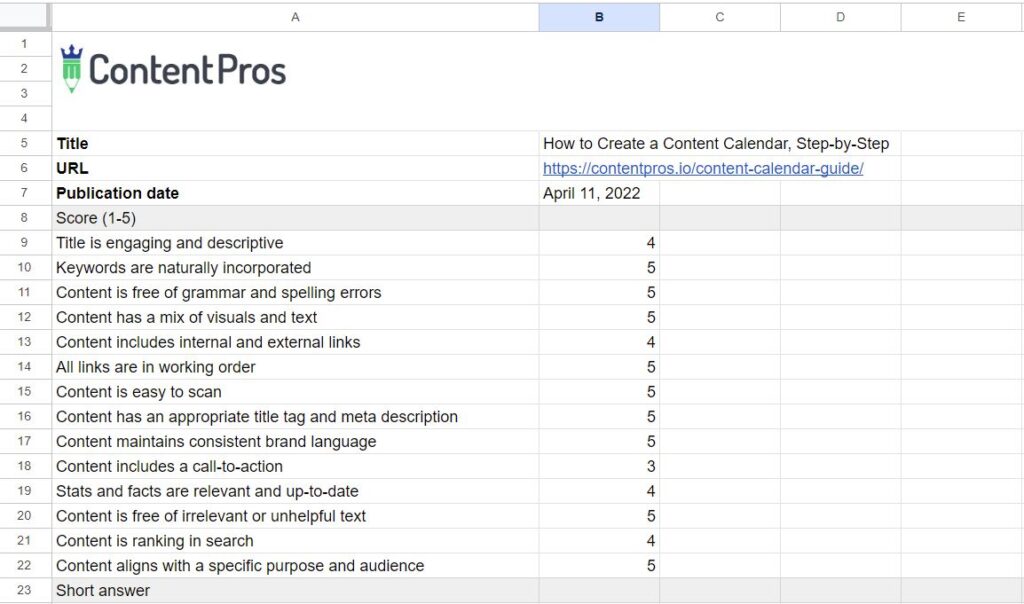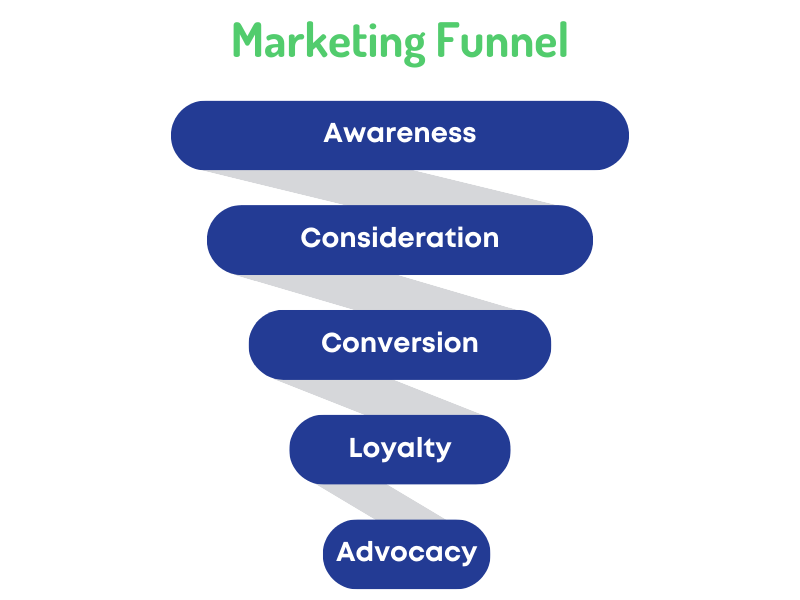Content marketers start the year strong with content calendars and big plans to make real impact in the digital space. But by the end of Q2, competing interests and priorities can derail your original content dreams. That’s why mid-year is the perfect time to do a content evaluation — take a step back and realign with your goals to end the year strong.
Plans change, new trends emerge, and budgets constantly shift. The content you’ve created so far might not be meeting your expectations. Continuing on the same path is Einstein’s definition of insanity in action, and it can lead to wasted budgets, effort, and time, not to mention lackluster results.
Here’s how to do a mid-year content evaluation to shore up your content marketing for maximum impact.
What Is a Content Evaluation?
A content evaluation is the process of assessing the quality, relevance, and effectiveness of your content assets. You might also hear this referred to as a content analysis.
Evaluations take the typical content audit a step further by knowing what assets you have and understanding how they’re performing.
The purpose of a content evaluation is to ensure your content is doing its job. It identifies areas for improvement and ensures you’re getting the most return on your efforts.
During a content evaluation, you’ll look for several key things, including:
- Whether the content is ranking in search
- Keywords the content ranks for
- Engagement metrics, such as likes, shares, and page views
- Whether others are linking to the content
- Whether the content meets the intended goal
- Areas for improvement
We’ll dive into these topics and other aspects in our step-by-step content evaluation process.
How to Do a Content Evaluation, Step By Step
We love processes here at Content Pros because they leave nothing to chance. Here’s the process we use to evaluate our own content performance:
1. Have a Purpose for Your Content Evaluation
Everything in content marketing has a purpose, including the reason for evaluating your content. Connect why you’re doing an evaluation with what you expect to happen next.
Do you plan on improving underperforming content?
Do you want to demonstrate ROI to your VP of Marketing?
Will the outcome of your evaluations inform your next piece of content?
Having a goal in mind before you start can help you get the most from your evaluations.

2. Use a Content Scorecard to Audit Your Content
Asking the right questions and capturing the right details can give valuable information and help you conduct a thorough evaluation. We recommend using a scorecard to ensure you hit all the right points. Scorecards can also give your marketing teams insights at a glance, making it easy to see how your content is performing.
Here are some items of interest to include on your scorecard review:
- Title is engaging and descriptive
- Keywords are naturally incorporated
- Content is free of grammar and spelling errors
- Content has a mix of visuals and text
- Content includes internal and external links
- All links are in working order
- Content is easy to scan
- Content has an appropriate title tag and meta description
- Content maintains consistent brand language
- Content includes a call-to-action
- Stats and facts are relevant and up-to-date
- Content is free of irrelevant or unhelpful text
- Content is ranking in search
- Content aligns with a specific purpose and audience
With these items, you can assign a letter or point grade to objectively rate each piece of content in your evaluation. This is helpful in maintaining brand standards for quality.
In addition, you can ask open-ended questions that require a little more digging. For example:
- What keywords does this content rank for?
- What additional keyword opportunities should we pursue?
- Does this content convert visitors? Why or why not?
- What improvements would be most beneficial to reach our goals?
In many cases, the answers in the first list can help to answer questions in the second list. For instance, if your content isn’t converting visitors, it might be because it’s not ranking well in search and therefore not reaching the intended audience.
We’ve compiled the above questions into an easy-to-use checklist template, which you can download for free. Feel free to tweak your evaluation criteria based on each type of written content, such as a blog post vs. social media post.
3. Take Inventory of Your Content
If you’ve been diligently following your content calendar, this step is straightforward. Take inventory of your content, then decide which pieces you’d like to evaluate.
If you have hundreds of assets, you might focus on the ones you’ve published this year or content in a specific stage of your conversion funnel (TOFU/MOFU/BOFU).

4. Identify High and Low Performers
Using your evaluation checklist, start evaluating each piece of content against your criteria for quality and performance. You’ll likely need a mix of tools for this process, including:
- Keyword research tools (such as Semrush or Ahrefs) to see organic rankings and keyword opportunities
- Google Analytics or other website analytics to gauge traffic, page views, view time, and bounce rate
- Social media analytics to gauge reach, views, and engagement
- CRM data to track leads and conversions
Additional tools can also come in handy. For instance, if you want to gauge engagement, heat mapping tools can show you the complete journey your user takes on a specific web page, such as scrolling, clicking, and other mouse movements. You can set up a one-day test on a specific web page to capture heat map data and reveal potential distractions on the page that prevent the user from converting.
Usability Hub is a great tool to get objective opinions about your web page content. This tool ensures your message is getting across to visitors within the first five seconds. Testers are shown your web page for five seconds, then asked what the content was about. If they can accurately describe your content, consider it a win. If not, you might need to clarify your headline and introductory information.
You can also use tools like Surfer or TextOptimizer to get suggestions on what to add, delete, or otherwise improve. Text Optimizer is a great way to align your copy with a person and search intent. It gives you quick wins and shows you the terms and phrases Google associates with a specific query.
5. Select Content for Improving and Repurposing
Based on your findings in the previous step, select the content you’d like to improve and make a list of the required changes. You’ve already removed the guesswork in figuring out what needs to change. Once you’ve updated your content, set a date to re-evaluate it and see how your changes improved its performance.
Now is also a good opportunity to repurpose your improved content. For instance, you can turn a single blog post into a lead magnet and a series of social media posts with infographics. You might also turn long-form articles into a series of shorter blog posts for a newsletter campaign.
You can also outsource updating and optimizing content to a content agency. Professional content writers can make the changes on your behalf, edit and polish the content, and deliver a ready-to-publish piece quickly.
6. Define New Content Marketing Goals
Based on your content performance, now is a good time to re-evaluate your content marketing goals for the rest of the year. Evaluations can surface many different findings, including unintended results from your content. For instance, you might have capitalized on a new keyword that led to a new vertical or customer persona.
Take a moment to realign your content goals with your content calendar. Decide what new content to create, what to prioritize, and what can wait.

7. Report on Your Findings
Compiling your findings into a report gives you something to refer back to in the future. More importantly, it gives you tangible evidence of your content’s performance and what your audience finds valuable.
Multiple stakeholders in your organization can benefit from this report, including sales teams, marketing managers, customer service teams, and your outsourced content agency. You can use your scorecard or template to document your findings and easily share them with others.
Content Evaluation FAQs
Do you have more questions as a content evaluator? Refer to the below frequently asked questions.
Why are content evaluations useful?
Content evaluations show you what’s working and what’s not in your content marketing. They take a systematized approach so you can score each piece of content against the same criteria and find areas for improvement.
How often should I do a content evaluation?
Depending on how much content you’re interested in creating, we recommend doing a content evaluation every quarter or twice per year. A mid-year content evaluation is a great opportunity to stay aligned with your content goals.
How do you evaluate content?
It helps to have a scorecard with criteria that indicates high quality and performance. Among these criteria include engagement metrics, absence of errors, SEO best practices (such as metadata, links, and keywords), and conversion rates.
Strengthen Your Content Marketing with Content Pros
Evaluating your content performance is an important part of every overarching marketing strategy. To help you maximize your impact, our team of professional content writers is here to help. Reach out to see how we can elevate your evaluations!

